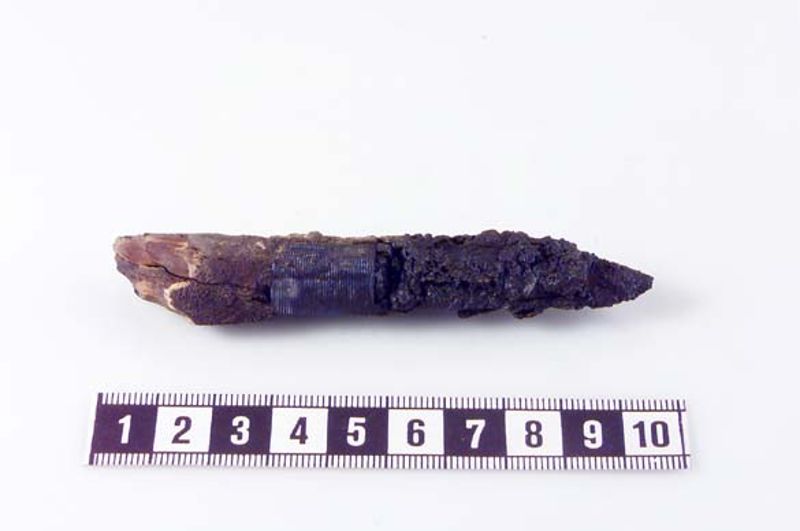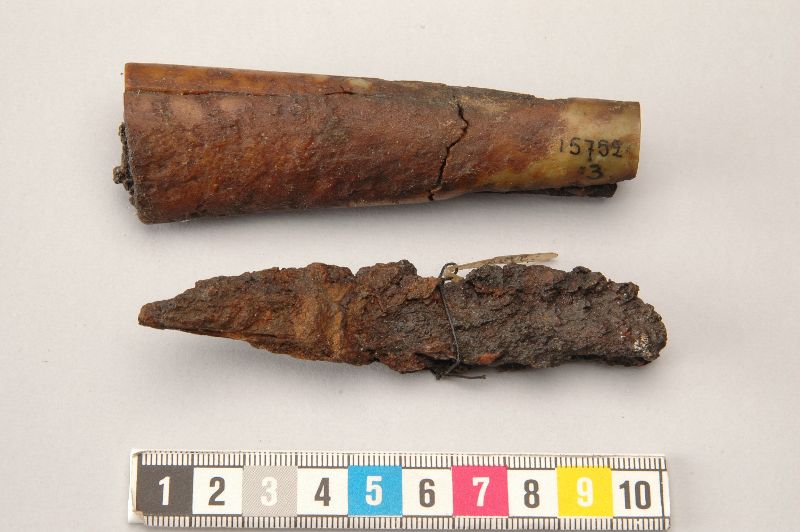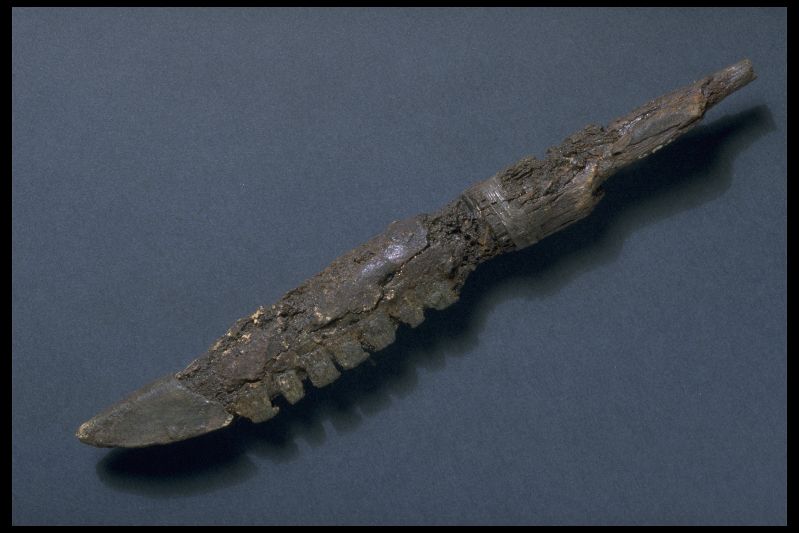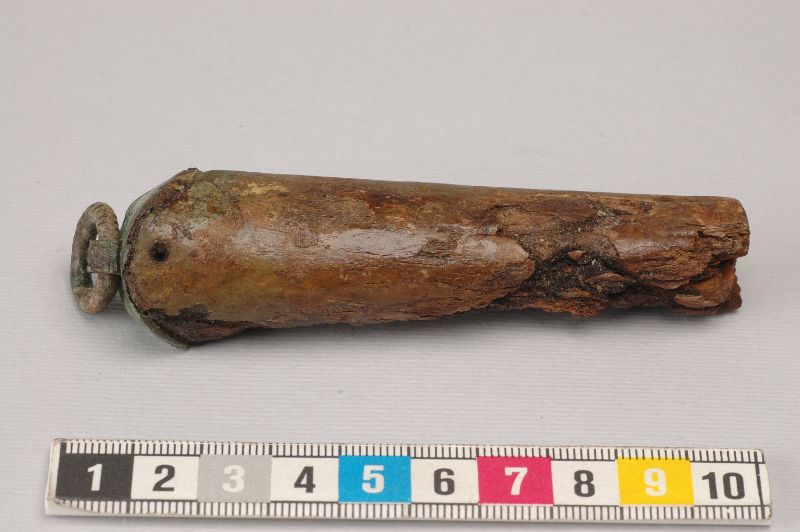| Author |
Message |
Luka Borscak

|
 Posted: Wed 28 Mar, 2012 3:22 am Post subject: Broken back seax grip? Posted: Wed 28 Mar, 2012 3:22 am Post subject: Broken back seax grip? |
 |
|
Hello people.  I got a new seax blade from Paul Binns, very impressive piece, 11" long blade, iron back, pattern welded middle and steel edge and I would like to get a grip as historical as possible for it. I read old threads about seax grips, but I thought maybe some new stuff got discovered in the mean time or some new hypothesis appeared. I got a new seax blade from Paul Binns, very impressive piece, 11" long blade, iron back, pattern welded middle and steel edge and I would like to get a grip as historical as possible for it. I read old threads about seax grips, but I thought maybe some new stuff got discovered in the mean time or some new hypothesis appeared.  So, is it still the safest way to grip a broken back seax with a straight, bare wood handle glued on the tang without any metal parts or wood covering? What style of decoration could there be on it if it was bare wood? Would ancient maker choose special part of a tree for its beauty and strength? Root for example? What kind of wood? Could such a seax be fitted to grip in some other way than just glued? I know these are hard to answer questions since there is so few archeological samples of surviving late seax grips but I think it doesn't hurt to ask, right? So, is it still the safest way to grip a broken back seax with a straight, bare wood handle glued on the tang without any metal parts or wood covering? What style of decoration could there be on it if it was bare wood? Would ancient maker choose special part of a tree for its beauty and strength? Root for example? What kind of wood? Could such a seax be fitted to grip in some other way than just glued? I know these are hard to answer questions since there is so few archeological samples of surviving late seax grips but I think it doesn't hurt to ask, right?  Below is the Paul's picture of the seax blade. Below is the Paul's picture of the seax blade.

|
|
  |
 |
Johan Gemvik

|
 Posted: Wed 28 Mar, 2012 4:10 am Post subject: Posted: Wed 28 Mar, 2012 4:10 am Post subject: |
 |
|
That's an excelent blade.
There are many handle variants and materials that was used historically for seaxes.
The most common for broken backs was probably as you say a straight wooden handle, and these could be as long as the tang or far longer. But there were also hand width length conical and teardrop cross section handles, often with one or more metal end plates. Horn, and antler would also have been common materials, and in some cases bone.
If you want to decorate a plain straigh handle then you could use knotwork carvings, alternating ribbing or the simple rings with center holes seen on a lot of iron age combs.
If you want to replicate a well known find that fits with a large wide brokenback blade like this I'd start with looking at the Charlemagne seax. It's a long straight handle. This thread has some photos, scroll down to see the original find since the reproduction, although very nice, is a little off.
http://www.swordforum.com/forums/showthread.p...harlemagne

(photo borrowd from the swordforum thread)
Then there are the smaller scandinavian brokenback knives of course.
Here's a different type of handle on a small bladed viking age brokenback seax from the north of Sweden. Conical wood handle with silver wire decoration at the blade end. Lots of swedish finds have these silver wire windings at the blade end.

Here's another knife from Gotland. The handle is bone.

Yet another one, this one from Adelsö (close to Birka) again with wood handle and silver wire winding at the blade end. This one shows a lot of interesting sceath parts. The blade isn't serrated, it's the bronze edging clamps on the sceath that have partly fused with the blade.

A handle, May be from any type of blade, but it's really tiny.

"The Dwarf sees farther than the Giant when he has the giant's shoulder to mount on" -Coleridge
|
|
  |
 |
Luka Borscak

|
 Posted: Wed 28 Mar, 2012 11:00 am Post subject: Posted: Wed 28 Mar, 2012 11:00 am Post subject: |
 |
|
Thanks Johan! That Charlemagne seax grip has a metal covering at the end it seems, do you know how is it attached?
About the other pictures, they are nice to see and useful, but they don't show big broken back seaxes so I don't know how sure it is that such a different type of seax would be made with similar style grip. Especially if the dates and areas are not the area and period of large broken back seaxes.
|
|
  |
 |
G Ezell
Industry Professional

Location: North Alabama Joined: 22 Dec 2003
Posts: 235
|
 Posted: Wed 28 Mar, 2012 10:23 pm Post subject: Posted: Wed 28 Mar, 2012 10:23 pm Post subject: |
 |
|

Evidence points towards broken back seaxes having fairly long, straight handles, not only period illustrations but also the surviving sheathes. The Aachen seax has a handle, roughly from memory, of 8"+ long, made of horn (likely bovine). Finding a solid, straight piece of horn of this size is difficult. Other possible handle materials would be masur birch (still popular in the Norse countries), boxwood, pear or other fruitwood, maple, walnut... any native tree would be a possible candidate for a wooden handle. Look for woods traditionally used for tool and knife handles in the area and you will not go wrong. Ivory would be an expensive but upscale choice.
It is possible the handles could be leather covered, some earlier continental saxes show evidence of this, and/or carving, but unfortunately there is no surviving handle I am aware of for a broken back than the Aachen seax. The metal covering (silver? bronze? not quite sure), if one looks closely is held in place by tiny nails/tacks. A plate between the handle and blade is quite unlikely, and a guard is definitely out.
That is a beautiful blade!
" I have found that it is very often the case that if you state some absolute rule of history, there will be an example, however extremely unusual, to break it."
Gabriel Lebec
https://www.facebook.com/relicforge
|
|
   |
 |
Luka Borscak

|
 Posted: Sat 31 Mar, 2012 4:33 am Post subject: Posted: Sat 31 Mar, 2012 4:33 am Post subject: |
 |
|
|
Thanks! Interesting picture! So, basically there is no archeological proof for anything else on broken backs than what we see on "Charlemagne" seax? Honestly, I don't feel completely secure about the grip being only glued and force fitted on the tang.
|
|
  |
 |
Luka Borscak

|
 Posted: Sat 31 Mar, 2012 7:47 am Post subject: Posted: Sat 31 Mar, 2012 7:47 am Post subject: |
 |
|
|
Btw, is the Charlemagne seax hilt wood or bone? I read some contrasting views about that...
|
|
  |
 |
|
Jeremy V. Krause
|
 Posted: Sat 31 Mar, 2012 10:12 am Post subject: Posted: Sat 31 Mar, 2012 10:12 am Post subject: |
 |
|
| Luka Borscak wrote: | | Thanks! Interesting picture! So, basically there is no archeological proof for anything else on broken backs than what we see on "Charlemagne" seax? Honestly, I don't feel completely secure about the grip being only glued and force fitted on the tang. |
A wittle-tang grip made of wood would be the most conservative and safest hiistorical choice.
|
|
  |
 |
Michal Plezia
Industry Professional

|
 Posted: Sat 31 Mar, 2012 10:25 am Post subject: Posted: Sat 31 Mar, 2012 10:25 am Post subject: |
 |
|
| Luka Borscak wrote: | | Thanks! Interesting picture! So, basically there is no archeological proof for anything else on broken backs than what we see on "Charlemagne" seax? Honestly, I don't feel completely secure about the grip being only glued and force fitted on the tang. |
Don't worry. If you use epoxy (or maybe bone glue if you want to be more historically accurate) combined with tight fit of the handle the joining can be more resistant than the wood itself. Gluing is a common technique used also by modern knifemakers, and it works.
www.elchon.com
Polish Guild of Knifemakers
The sword is a weapon for killing, the art of the sword is the art of killing. No matter what fancy words you use or what titles you put to
it that is the only truth.
|
|
   |
 |
G Ezell
Industry Professional

Location: North Alabama Joined: 22 Dec 2003
Posts: 235
|
 Posted: Sat 31 Mar, 2012 8:15 pm Post subject: Posted: Sat 31 Mar, 2012 8:15 pm Post subject: |
 |
|
| Luka Borscak wrote: | | Btw, is the Charlemagne seax hilt wood or bone? I read some contrasting views about that... |
It is horn, I believe, of the bovine variety.
| Luka Borscak wrote: | | Thanks! Interesting picture! So, basically there is no archeological proof for anything else on broken backs than what we see on "Charlemagne" seax? Honestly, I don't feel completely secure about the grip being only glued and force fitted on the tang. |
Other than the images Mr. Gemvik posted (nice images btw, some of those are new to me), I do not know of any.
I've had the same reservations to the glue only construction. I use acraglass... not exactly period correct, but it is one of the strongest adhesives I know of. Or I pin them and call it handle decoration... I have one made about 1 1/2 years ago using your basic 5 minute epoxy and I've used it quite a bit, with no loosening yet. My thinking is that if it didn't work they would have used another method to fix the blade to the handle. Cutler's rezin is the way to go if you want to use a period correct adhesive, there are several formulas floating around the internet that I keep meaning to try. I have one made about 1 1/2 years ago using your basic 5 minute epoxy and I've used it quite a bit, with no loosening yet. My thinking is that if it didn't work they would have used another method to fix the blade to the handle. Cutler's rezin is the way to go if you want to use a period correct adhesive, there are several formulas floating around the internet that I keep meaning to try.
Perhaps they will figure out the 'roman superglue' formula...
" I have found that it is very often the case that if you state some absolute rule of history, there will be an example, however extremely unusual, to break it."
Gabriel Lebec
https://www.facebook.com/relicforge
|
|
   |
 |
|
Scott Woodruff
|
 Posted: Sat 31 Mar, 2012 8:56 pm Post subject: Posted: Sat 31 Mar, 2012 8:56 pm Post subject: |
 |
|
|
I have glued in a few knife handles and I find that wooden handles will break and splinter before they fall off. I just use Elmer's wood glue or sometimes just Elmer's white glue like you used in elementary school. On my last knife, I wrapped the grip with wool yarn and glued on a thin leather covering. This gave a very sturdy grip, which is a good thing on a knife with a 13" blade. Such a construction would probably be your best bet both from a strength perspective and historical accuracy. Of course, if you really are not comfortable with just glue, you could easily hide a pin under the leather wrap.
|
|
  |
 |
Johan Gemvik

|
 Posted: Sun 01 Apr, 2012 1:58 pm Post subject: Posted: Sun 01 Apr, 2012 1:58 pm Post subject: |
 |
|
For a very strong historical glue you can use cheese aka casein glue. You can buy it ready to use, or make it fairly easily. I've made and used it a lot. Let me know if you want instructions on how to make some.
For some equally strong modern glues I'd recommend epoxy as Michan says or Loctite PL 400 (which a lot of professional knifemakers use). The good thing about PL 400 is that is works both as adhesive and wood filler at the same time, and looks like bone glue when done but without the awful smell.
"The Dwarf sees farther than the Giant when he has the giant's shoulder to mount on" -Coleridge
|
|
  |
 |
Luka Borscak

|
 Posted: Sun 01 Apr, 2012 3:08 pm Post subject: Posted: Sun 01 Apr, 2012 3:08 pm Post subject: |
 |
|
|
I will talk to Alojz, (local weapon maker) who will do the grip, to see what he thinks, what glue we should use.
|
|
  |
 |
Harry Marinakis

|
 Posted: Sat 27 Apr, 2013 9:51 am Post subject: Posted: Sat 27 Apr, 2013 9:51 am Post subject: |
 |
|
Does anyone know of any resources that describe seax grips by Century?
I am getting a seax blade that is likely 5th or 6th Century and need to get a period-appropriate handle.
Firesteel Designs
Hand-crafted good lovingly infused with hemoglobin
|
|
  |
 |
G Ezell
Industry Professional

Location: North Alabama Joined: 22 Dec 2003
Posts: 235
|
 Posted: Sun 28 Apr, 2013 12:22 pm Post subject: Posted: Sun 28 Apr, 2013 12:22 pm Post subject: |
 |
|
| Harry Marinakis wrote: | Does anyone know of any resources that describe seax grips by Century?
I am getting a seax blade that is likely 5th or 6th Century and need to get a period-appropriate handle. |
I was hoping someone would know, unfortunately I do not. 5-6th century is very early for saxes...
" I have found that it is very often the case that if you state some absolute rule of history, there will be an example, however extremely unusual, to break it."
Gabriel Lebec
https://www.facebook.com/relicforge
|
|
   |
 |
Harry Marinakis

|
 Posted: Mon 19 May, 2014 11:59 am Post subject: Posted: Mon 19 May, 2014 11:59 am Post subject: |
 |
|
Well.... I had Ben Potter finish my seax blade.

|
|
  |
 |
G Ezell
Industry Professional

Location: North Alabama Joined: 22 Dec 2003
Posts: 235
|
 Posted: Mon 19 May, 2014 1:35 pm Post subject: Posted: Mon 19 May, 2014 1:35 pm Post subject: |
 |
|
Nice one Harry! Ben and Owen both do wonderful work.
" I have found that it is very often the case that if you state some absolute rule of history, there will be an example, however extremely unusual, to break it."
Gabriel Lebec
https://www.facebook.com/relicforge
|
|
   |
 |
Mikko Kuusirati

|
 Posted: Mon 19 May, 2014 3:50 pm Post subject: Posted: Mon 19 May, 2014 3:50 pm Post subject: |
 |
|
| Luka Borscak wrote: | | Thanks! Interesting picture! So, basically there is no archeological proof for anything else on broken backs than what we see on "Charlemagne" seax? Honestly, I don't feel completely secure about the grip being only glued and force fitted on the tang. |
I can personally attest it works perfectly on this monster of a thing!
Do it right and it's more than sturdy enough for what you've got there. 
"And sin, young man, is when you treat people like things. Including yourself. That's what sin is."
— Terry Pratchett, Carpe Jugulum
|
|
  |
 |
|
|

